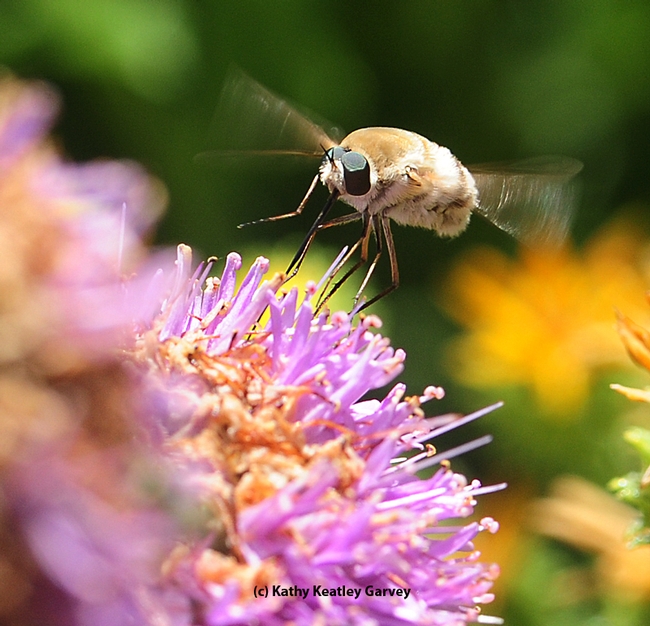- Author: Kathy Keatley Garvey
So patient, so passionate.
The praying mantis looked hungry last Thursday when it perched on a coneflower in the half-acre Häagen-Dazs Honey Bee Haven on Bee Biology Road, University of California, Davis.
Where's breakfast? Where's lunch? Where's dinner?
Nowhere to be found.
A few honey bees and sweat bees buzzed around the predator, but didn't land.
The praying mantis changed positions, much like a fisherman who feels "skunked" in one place will try his luck at another site.
It crawled up, down and around the flower.
Nothing.
Half an hour later, it slid beneath the coneflower, out of the hot sun. An umbrella for shade, a place to rest, a place to prey...




- Author: Kathy Keatley Garvey
Have you ever seen a bee fly, a member of the family Bombylidae?
It's about the size of some bees. It buzzes like a bee. But you can quickly tell it's not a bee by its behavior. It's a fast-moving, long-legged, fuzzylike critter that darts in and around flowers, grabbing nectar on the go, before buzzing off again.
It's curious little insect. Its long tongue (proboscis) is so long you're inclined to say "What? Is that for real?"
It is.
Like a fly, it has two wings (unlike bees, which have four).
We spotted this one pollinating the flowers behind the Lab Sciences Building at the University of California, Davis. The adults feed on nectar and pollen.
In their larval stage, bee flies parasitize the eggs and larvae of ground-nesting bees, beetles and wasps.
Says Wikipedia: "Although insect parasitoids usually are fairly host-specific, often highly host-specific, some Bombyliidae are opportunistic and will attack a variety of hosts."
Biologist Beatriz Moisset, in writing a "Pollinator of the Month" piece for the U.S. Forest Service in celebration of wildflowers, called it "A Pollinator with a Bad Reputation." She also blogs about Pollinators.


- Author: Kathy Keatley Garvey
It was definitely a hot spot.
Honey bees foraging last week on a pomegranate tree on Hopkins Road, west of the UC Davis main campus, competed for food on hundreds of blossoms.
We counted five honey bees on one blossom alone in what amounted to a pushing/shoving match.
Most of the bees probably came from the nearby apiary at the Harry H. Laidlaw Jr. Honey Bee Research Facility on Bee Biology Road, off Hopkins Road.
The pomegranate is an ancient fruit and the honey bee is an ancient insect. Millions of years ago, they grew up together in the Mediterranean region of southern Europe. European colonists brought the honey bee to our Eastern coast (Jamestown colony) in 1622; honey bees finally arrived in California in 1853. The pomegranate trees were introduced to California in 1769.
Together again...



- Author: Kathy Keatley Garvey
(Editor's note: This event has been postponed until the fall of 2013. Details pending.)
Mark your calenders!
The Honey and Pollination Center at the University of California, Davis, is planning a "Luncheon in the Garden" on Sunday, June 2 from noon to 3 p.m. in the Good Life Garden at the Robert Mondavi Institute for Wine and Food Science on campus.
It promises to be a delightful afternoon.
Executive director Amina Harris says it will be a "dazzling five-course meal from appetizers to cheese and desserts. Each course features honeys from around the globe."
The luncheon, open to the public, supports and introduces the Honey and Pollination Center. Food and drink will be provided by chefs, apiaries, wineries and meaderies (think wine made from honey), and the farmers of California.
What is the Honey and Pollination Center? Its vision is to establish UC Davis as a global center of excellence and education on bees, honey and pollination.
Its mission:
- Promote the use of high quality honey in the California market, help ensure the sustainability of honey production in California, and showcase the importance of honey and pollination to the well-being of Californians.
- Spearhead efforts to gain support and assemble teams for research, education and outreach programs for various stakeholder groups including: (1) the beekeeping industry, (2) agricultural interests who depend on bee pollination, (3) backyard beekeepers, and (4) the food industry
Its specific goals are five-fold:
- To optimize university resources by coordinating a multidisciplinary team of experts in honeyproduction, pollination and bee health
- To expand research and education efforts addressing the production, nutritional value, health benefits, economics, quality standards and appreciation of honey
- To serve the various agricultural stakeholders that depend on pollination services
- To help the industry develop informative and descriptive labeling guidelines for honey and bee-related products to establish transparency in the marketplace
- To elevate the perceived value of varietal honey to producers and consumers through education, marketing, and truth-in-labeling with the end goal of increasing the consumption of honey
Tickets are $125 per person. Like to attend? Contact events manager Tracy Diesslin at (530) 752-5233 or at tdiesslin@ucdavis.edu.
And if you'd like to make a donation, contact Harris at (530) 754-9301 or aharris@ucdavis.edu.
Meanwhile, be sure to check out the newly created Facebook page.

- Author: Kathy Keatley Garvey
Symphony in the almond blossoms...
There's a wild almond tree planted in a field off Bee Biology Road at the University of California, Davis, that's incredibly beautiful.
Honey bees from the nearby apiary at the Harry H. Laidlaw Jr. Honey Bee Research Facility reunite on the blossoms, each bee seemingly vying for the best pollen to take back to her hive.
The tree is not quite in full bloom, but don't tell that to the bees. We captured a few images of them in flight, a moving symphony performance in the almonds.





